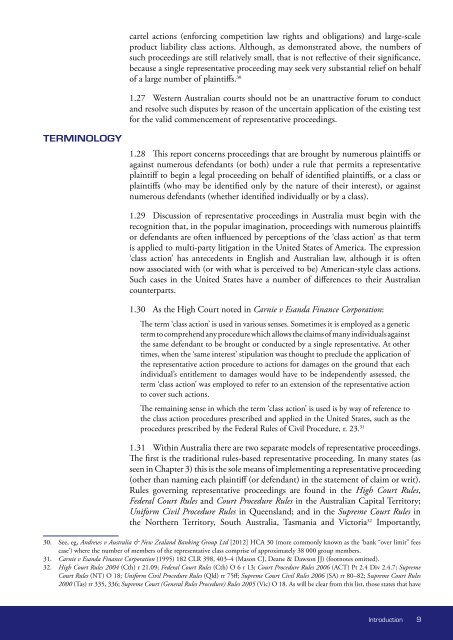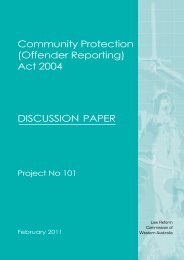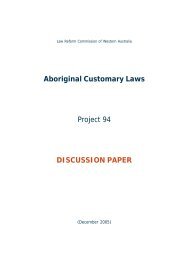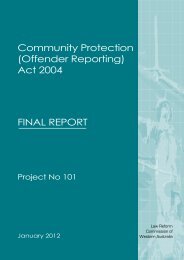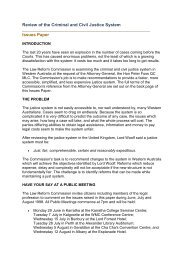Discussion Paper - Law Reform Commission of Western Australia
Discussion Paper - Law Reform Commission of Western Australia
Discussion Paper - Law Reform Commission of Western Australia
You also want an ePaper? Increase the reach of your titles
YUMPU automatically turns print PDFs into web optimized ePapers that Google loves.
cartel actions (enforcing competition law rights and obligations) and large-scale<br />
product liability class actions. Although, as demonstrated above, the numbers <strong>of</strong><br />
such proceedings are still relatively small, that is not reflective <strong>of</strong> their significance,<br />
because a single representative proceeding may seek very substantial relief on behalf<br />
<strong>of</strong> a large number <strong>of</strong> plaintiffs. 30<br />
1.27 <strong>Western</strong> <strong>Australia</strong>n courts should not be an unattractive forum to conduct<br />
and resolve such disputes by reason <strong>of</strong> the uncertain application <strong>of</strong> the existing test<br />
for the valid commencement <strong>of</strong> representative proceedings.<br />
Terminology<br />
1.28 This report concerns proceedings that are brought by numerous plaintiffs or<br />
against numerous defendants (or both) under a rule that permits a representative<br />
plaintiff to begin a legal proceeding on behalf <strong>of</strong> identified plaintiffs, or a class or<br />
plaintiffs (who may be identified only by the nature <strong>of</strong> their interest), or against<br />
numerous defendants (whether identified individually or by a class).<br />
1.29 <strong>Discussion</strong> <strong>of</strong> representative proceedings in <strong>Australia</strong> must begin with the<br />
recognition that, in the popular imagination, proceedings with numerous plaintiffs<br />
or defendants are <strong>of</strong>ten influenced by perceptions <strong>of</strong> the ‘class action’ as that term<br />
is applied to multi-party litigation in the United States <strong>of</strong> America. The expression<br />
‘class action’ has antecedents in English and <strong>Australia</strong>n law, although it is <strong>of</strong>ten<br />
now associated with (or with what is perceived to be) American-style class actions.<br />
Such cases in the United States have a number <strong>of</strong> differences to their <strong>Australia</strong>n<br />
counterparts.<br />
1.30 As the High Court noted in Carnie v Esanda Finance Corporation:<br />
The term ‘class action’ is used in various senses. Sometimes it is employed as a generic<br />
term to comprehend any procedure which allows the claims <strong>of</strong> many individuals against<br />
the same defendant to be brought or conducted by a single representative. At other<br />
times, when the ‘same interest’ stipulation was thought to preclude the application <strong>of</strong><br />
the representative action procedure to actions for damages on the ground that each<br />
individual’s entitlement to damages would have to be independently assessed, the<br />
term ‘class action’ was employed to refer to an extension <strong>of</strong> the representative action<br />
to cover such actions.<br />
The remaining sense in which the term ‘class action’ is used is by way <strong>of</strong> reference to<br />
the class action procedures prescribed and applied in the United States, such as the<br />
procedures prescribed by the Federal Rules <strong>of</strong> Civil Procedure, r. 23. 31<br />
1.31 Within <strong>Australia</strong> there are two separate models <strong>of</strong> representative proceedings.<br />
The first is the traditional rules-based representative proceeding. In many states (as<br />
seen in Chapter 3) this is the sole means <strong>of</strong> implementing a representative proceeding<br />
(other than naming each plaintiff (or defendant) in the statement <strong>of</strong> claim or writ).<br />
Rules governing representative proceedings are found in the High Court Rules,<br />
Federal Court Rules and Court Procedure Rules in the <strong>Australia</strong>n Capital Territory;<br />
Uniform Civil Procedure Rules in Queensland; and in the Supreme Court Rules in<br />
the Northern Territory, South <strong>Australia</strong>, Tasmania and Victoria 32 Importantly,<br />
30. See, eg, Andrews v <strong>Australia</strong> & New Zealand Banking Group Ltd [2012] HCA 30 (more commonly known as the ‘bank “over limit” fees<br />
case’) where the number <strong>of</strong> members <strong>of</strong> the representative class comprise <strong>of</strong> approximately 38 000 group members.<br />
31. Carnie v Esanda Finance Corporation (1995) 182 CLR 398, 403–4 (Mason CJ, Deane & Dawson JJ) (footnotes omitted).<br />
32. High Court Rules 2004 (Cth) r 21.09; Federal Court Rules (Cth) O 6 r 13; Court Procedure Rules 2006 (ACT) Pt 2.4 Div 2.4.7; Supreme<br />
Court Rules (NT) O 18; Uniform Civil Procedure Rules (Qld) rr 75ff; Supreme Court Civil Rules 2006 (SA) rr 80–82; Supreme Court Rules<br />
2000 (Tas) rr 335, 336; Supreme Court (General Rules Procedure) Rules 2005 (Vic) O 18. As will be clear from this list, those states that have<br />
Introduction 9


